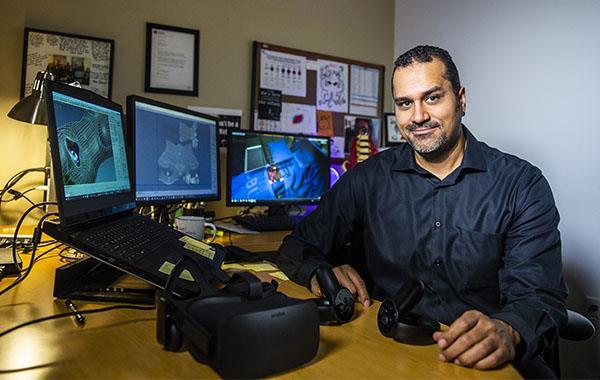Virtual Reality Surgery Simulator
Too often, women in developing countries die of cervical cancer because there aren’t enough surgeons trained to perform a lifesaving surgery. But a low-cost surgery simulation developed by a team of researchers from SMU (including SMU Guildhall faculty member Boris Fisher), UNC School of Medicine, and King’s College London has the potential to change that.
The VR Surgery Simulator was designed to reduce surgeon training costs through the combination of virtual reality simulation training using Oculus hardware, with remote real-time supervision of surgical trainees. When combined with clinical training, virtual reality technology has the potential to significantly reduce the time and cost of achieving surgical proficiency in resource-constrained settings.
Virtual Reality is a low-cost, scalable solution. The Virtual Reality Surgery Simulator (VRSS) project utilizes inexpensive, off-the-shelf virtual reality (VR) equipment designed for use with video games, resulting in a total cost of less than $2,000 USD per unit. The low cost of this technology makes it feasible to install surgery simulators in medical training facilities that could not previously afford them, thereby reducing the per-surgeon cost of surgical training and increasing the availability of trained surgeons in low-resource settings. VR surgery training aspires to create “pre-trained novices” who have mastered the psycho-motor skills, sensory acuity, and—to a lesser extent—cognitive planning of surgical tasks. Studies have shown that VR training can reduce training time needed for a novice to reach the skill level of an intermediately skilled surgeon by half. Similarly, studies have shown that VR-trained surgeons are much less likely to make errors than those who have completed standard training only.
The simulation starts in a virtual training room with guidance to help the trainee become comfortable working in a virtual environment. The VRSS trainee wears an Oculus Rift headset and holds an Oculus Touch wireless hand controller in each hand. On screen, the trainee is represented by an avatar, whose hands, only, are visible. Once the trainee is comfortable, the simulation transitions to a basic operating room environment, featuring an operating table with a tray of instruments and a virtual patient prepared for surgery.
The simulation begins at the point in the surgery where the key procedures for the training begin. Visual instructions are provided on a virtual monitor, and audio feedback is provided to reinforce procedural knowledge by guiding users through the steps. The headset view of each VR training session is recorded for review and reflection.

Learn More | Lifesaving VR in the News:
Research Feature
Virtual Reality Brings Cervical Cancer Surgery Training to Physicians